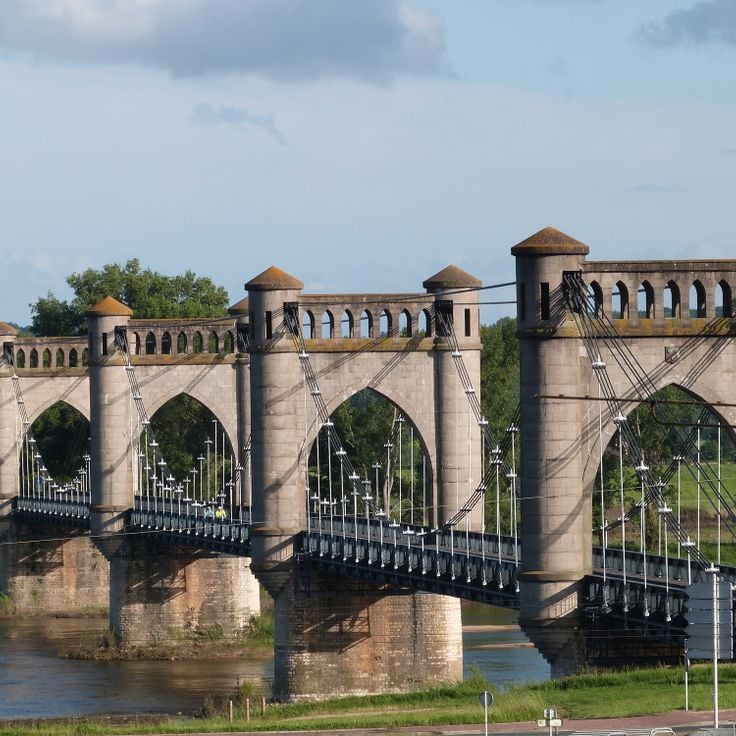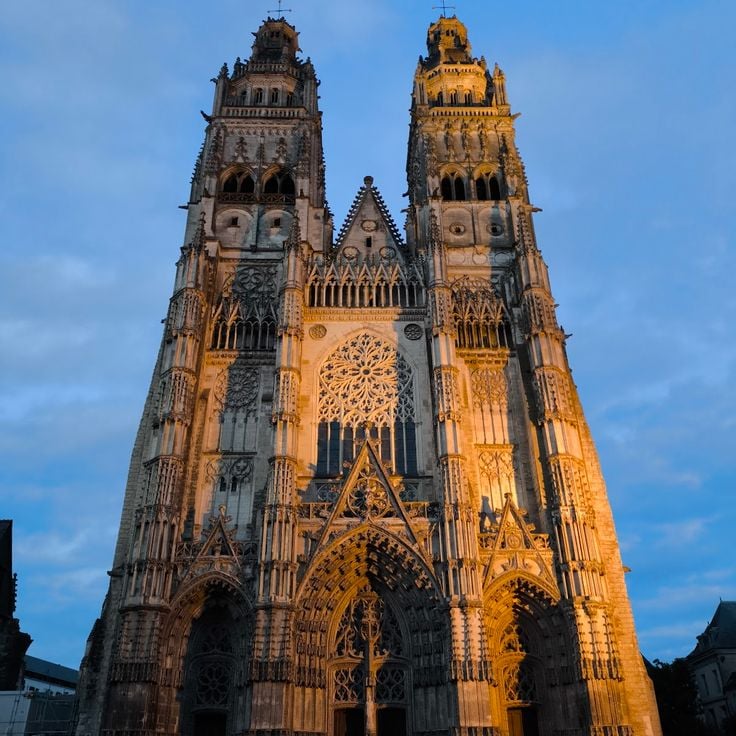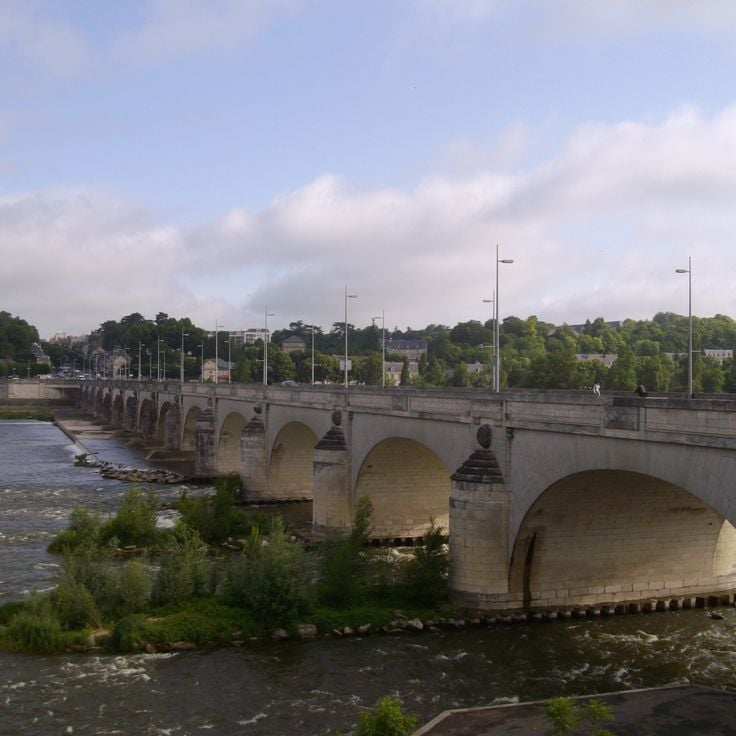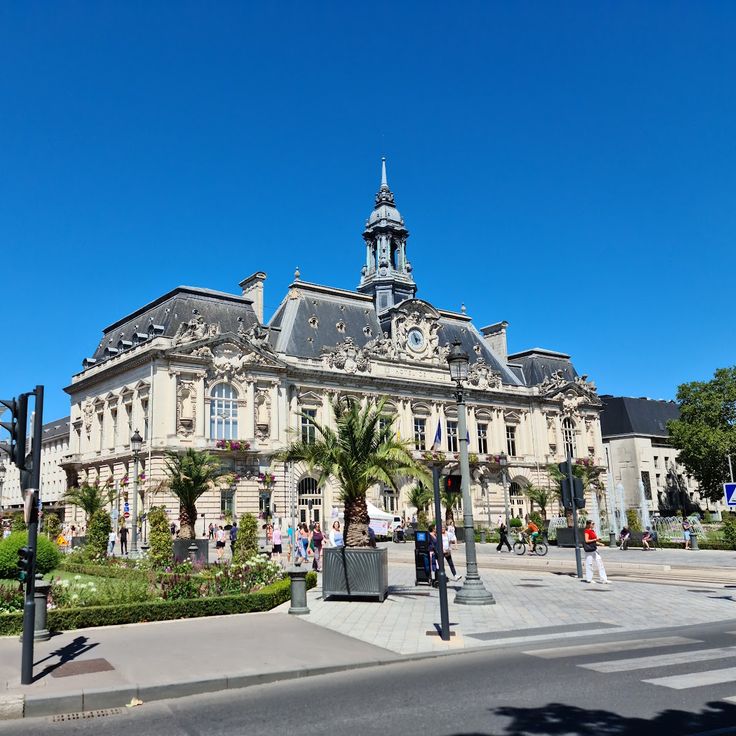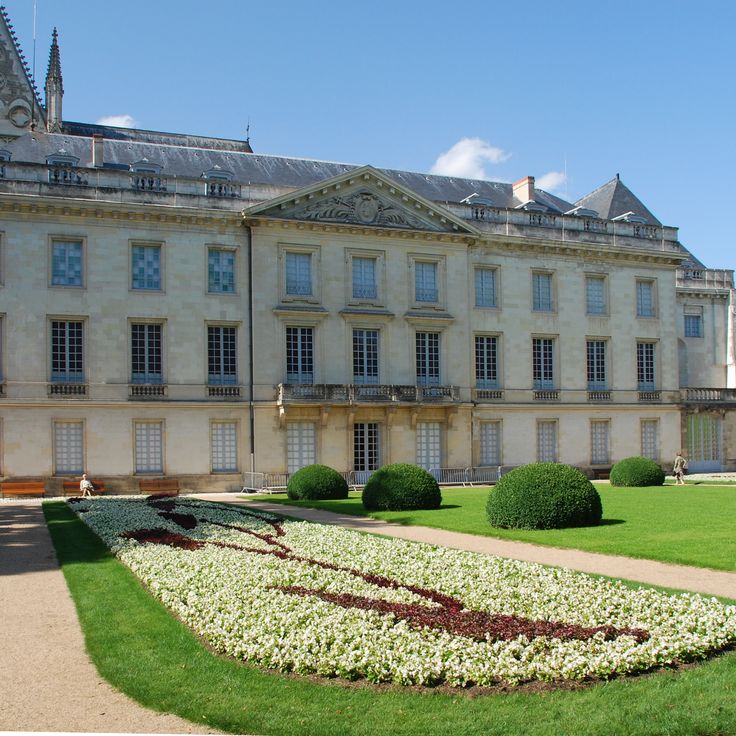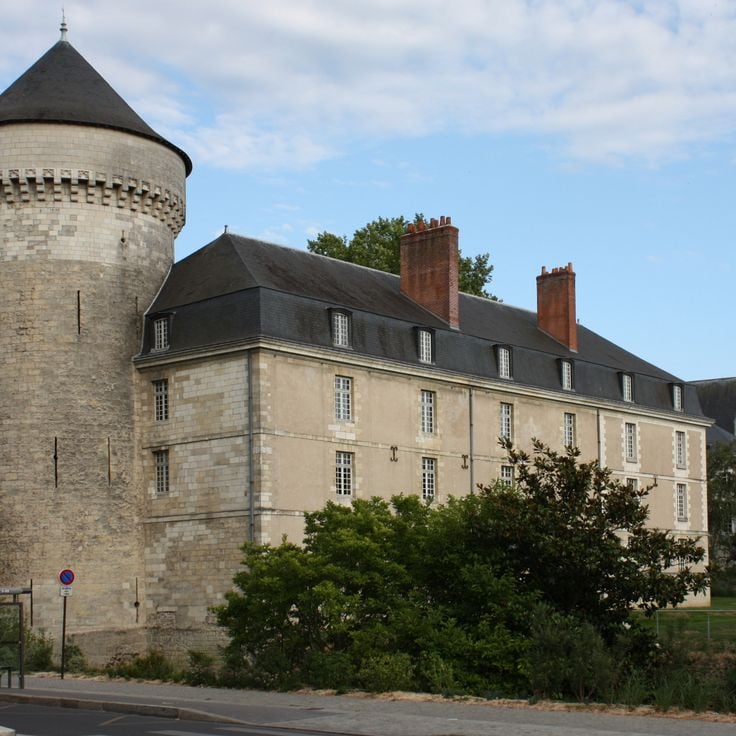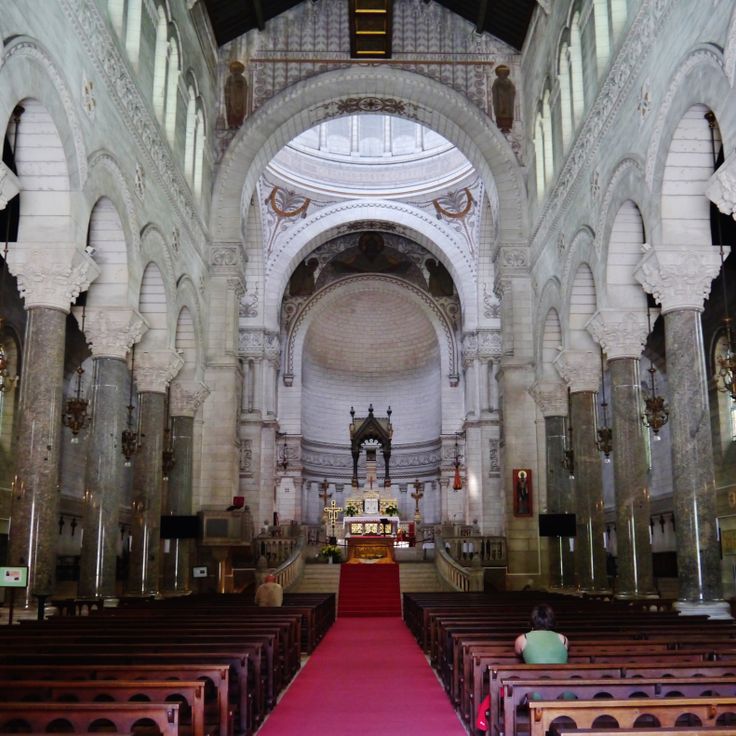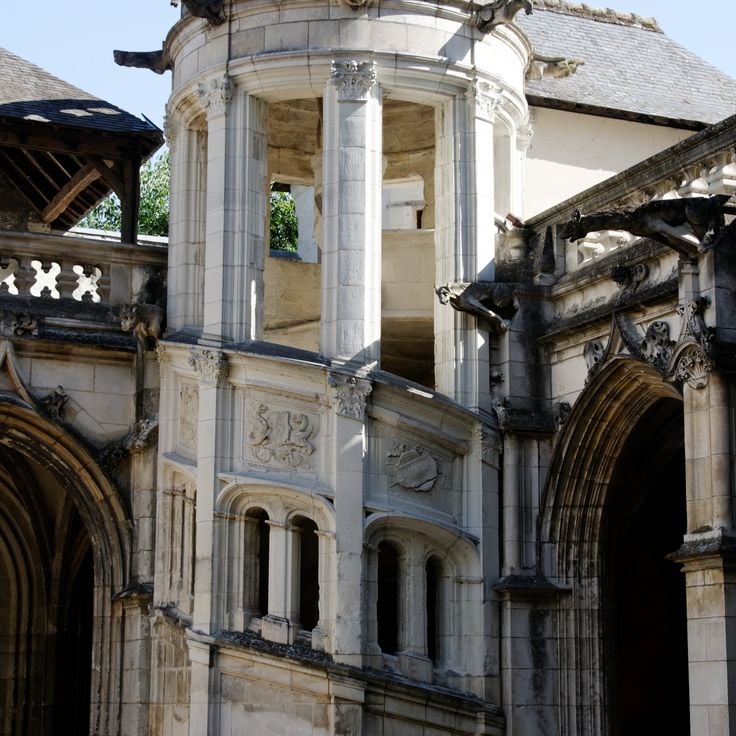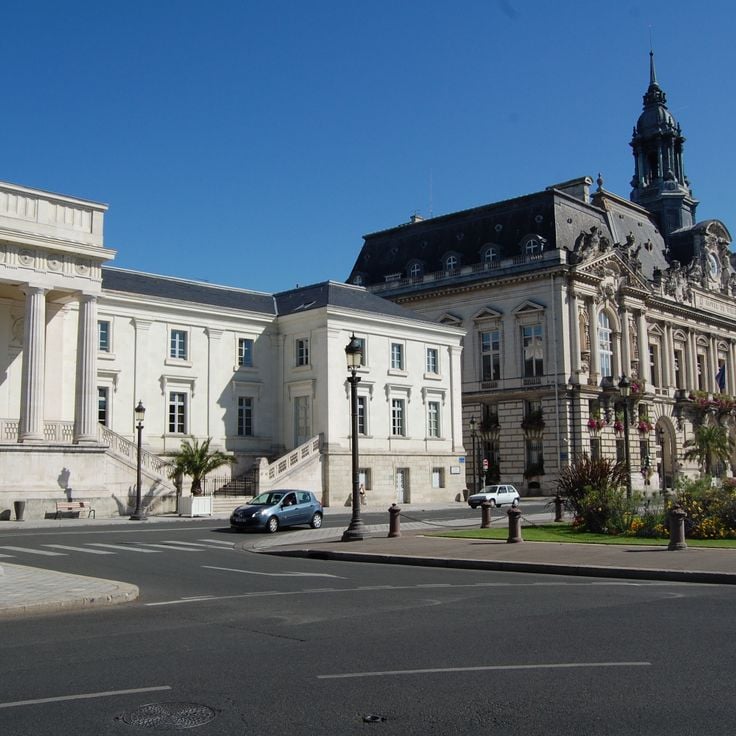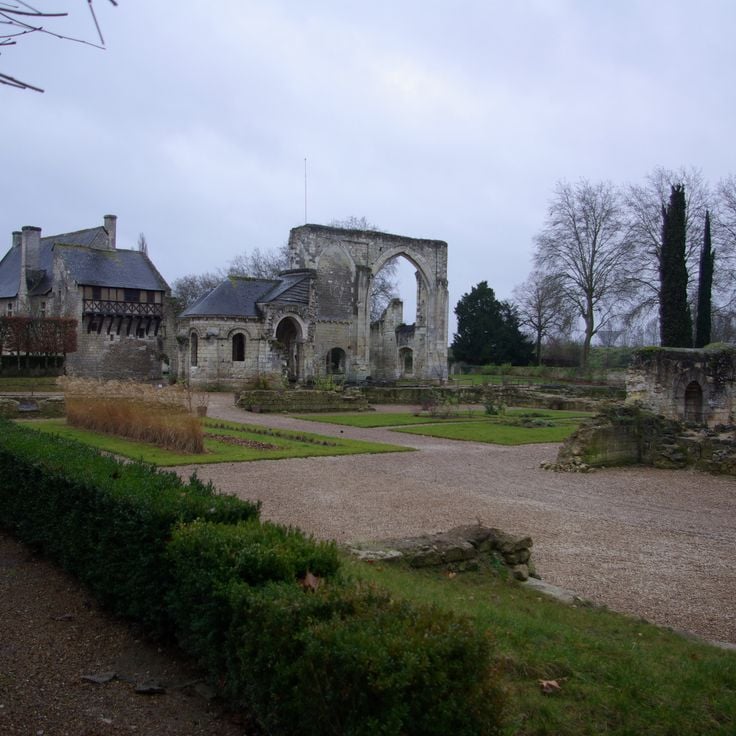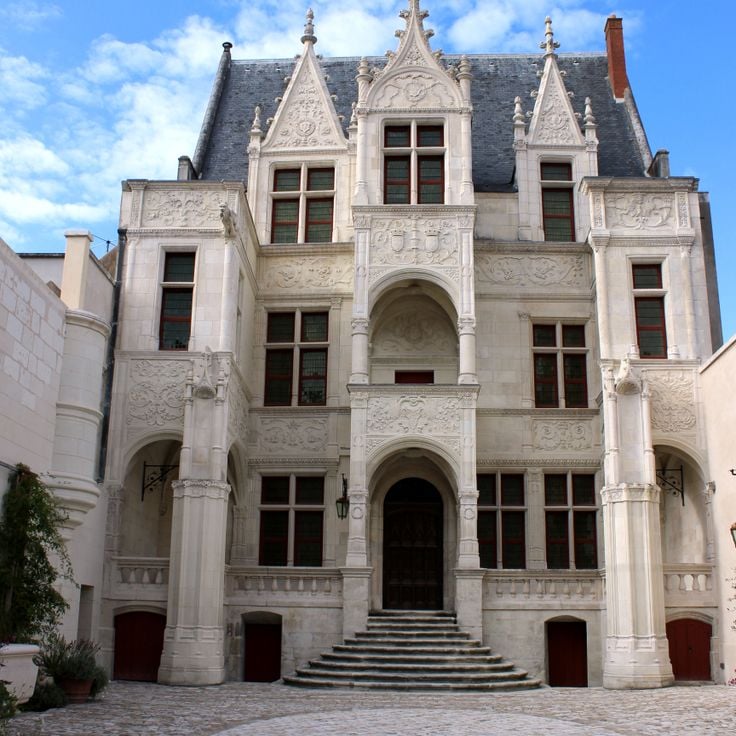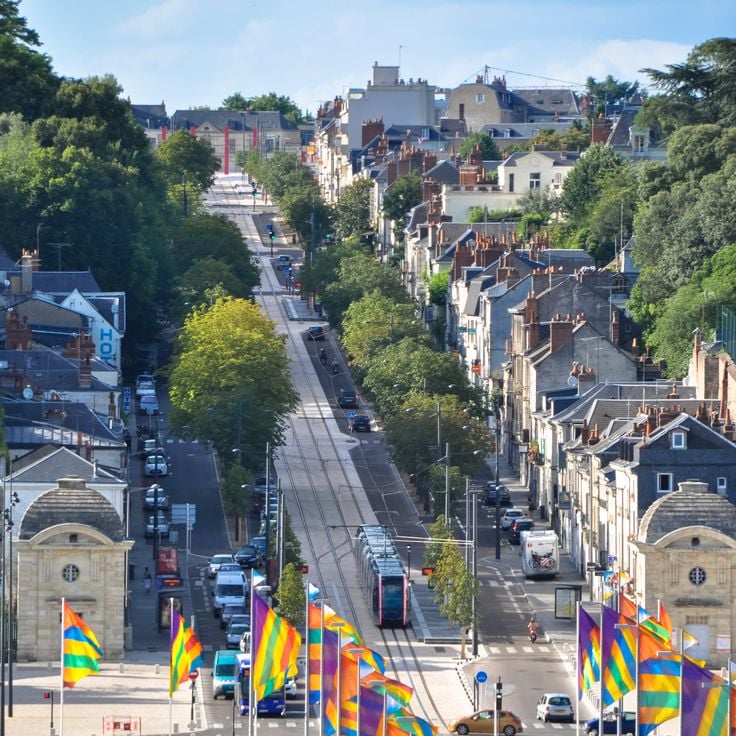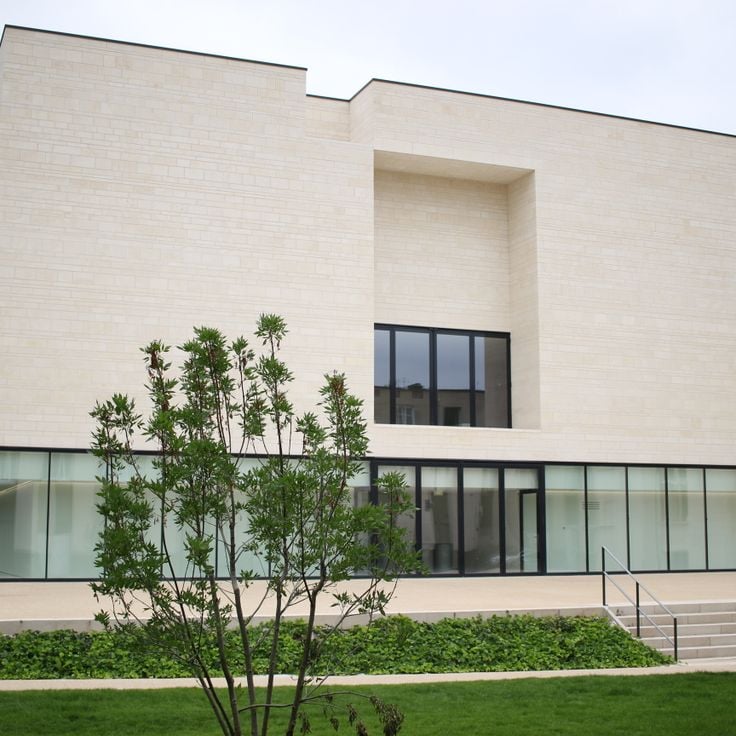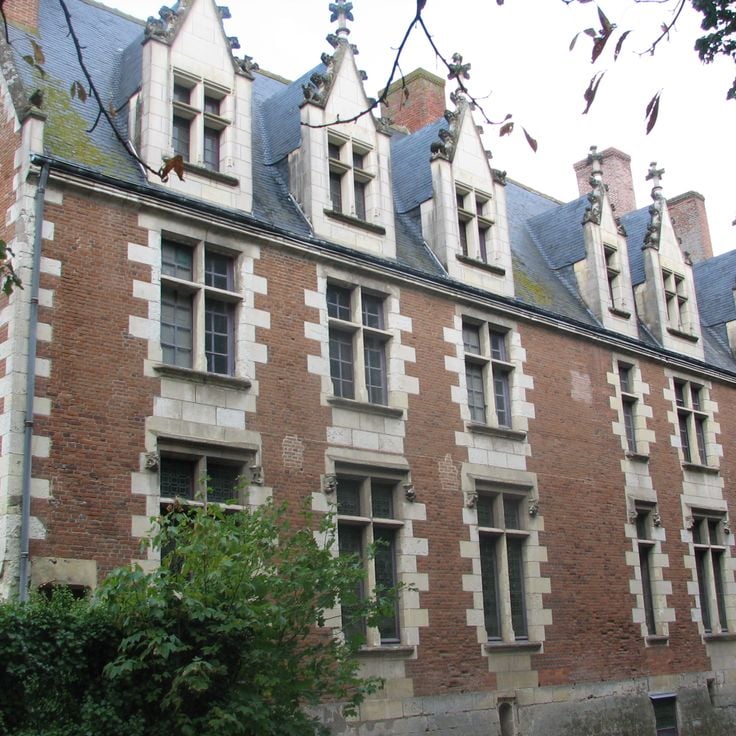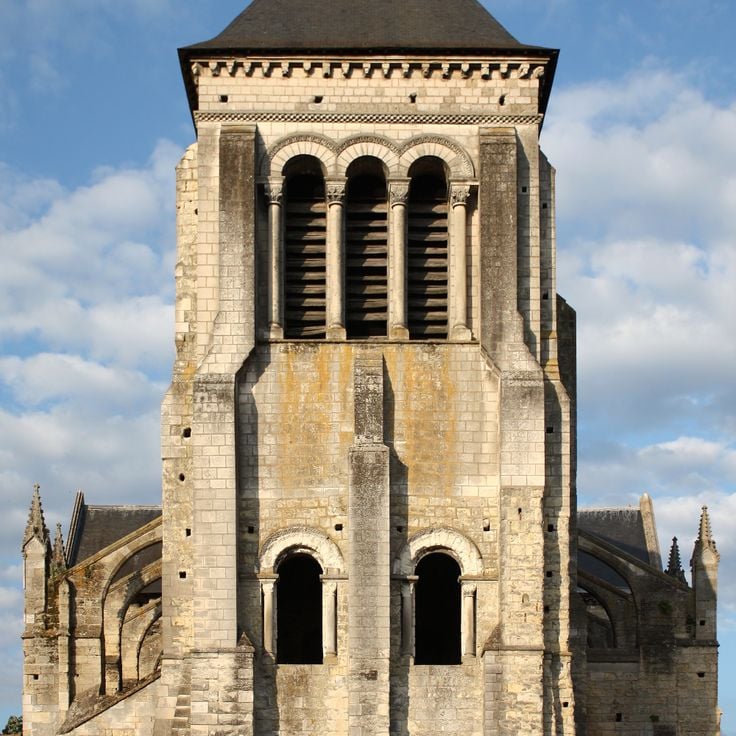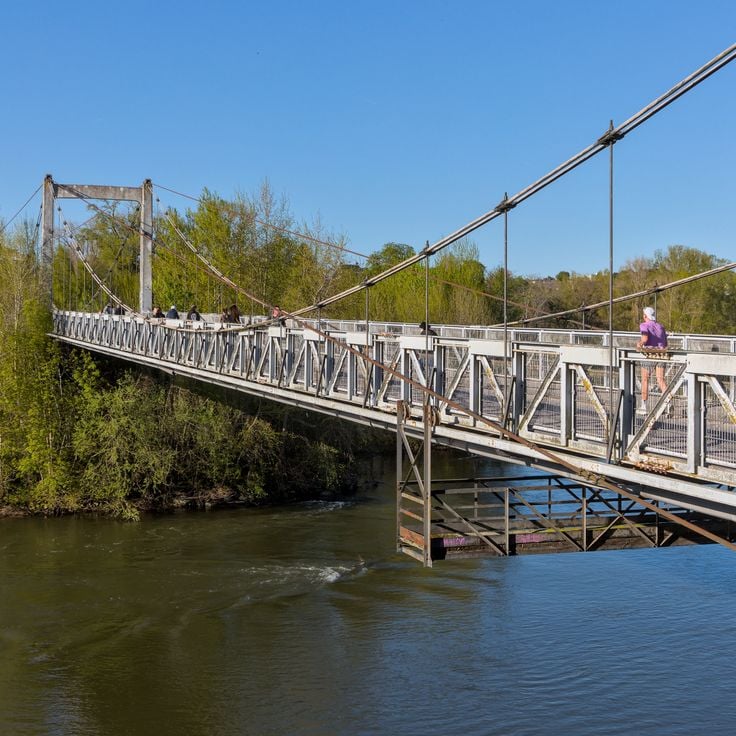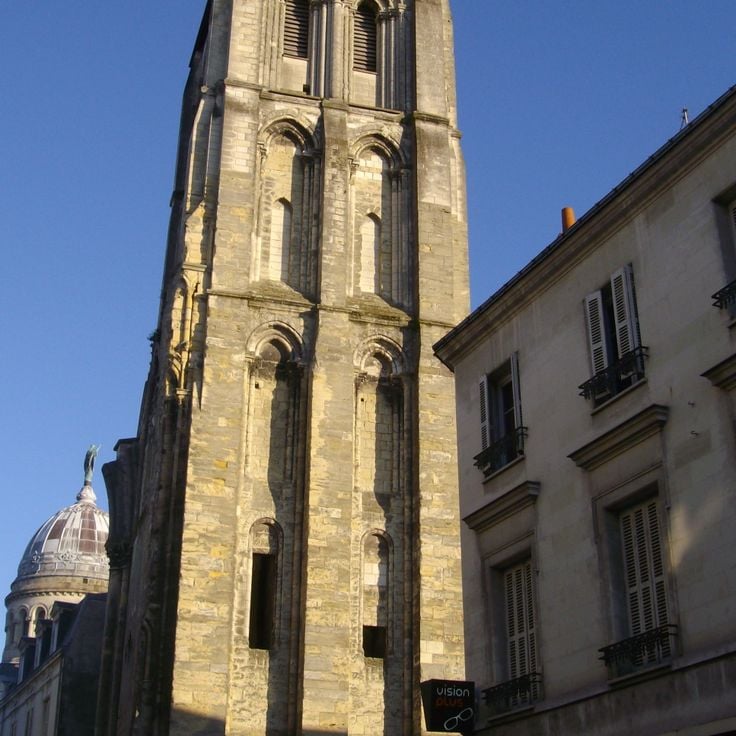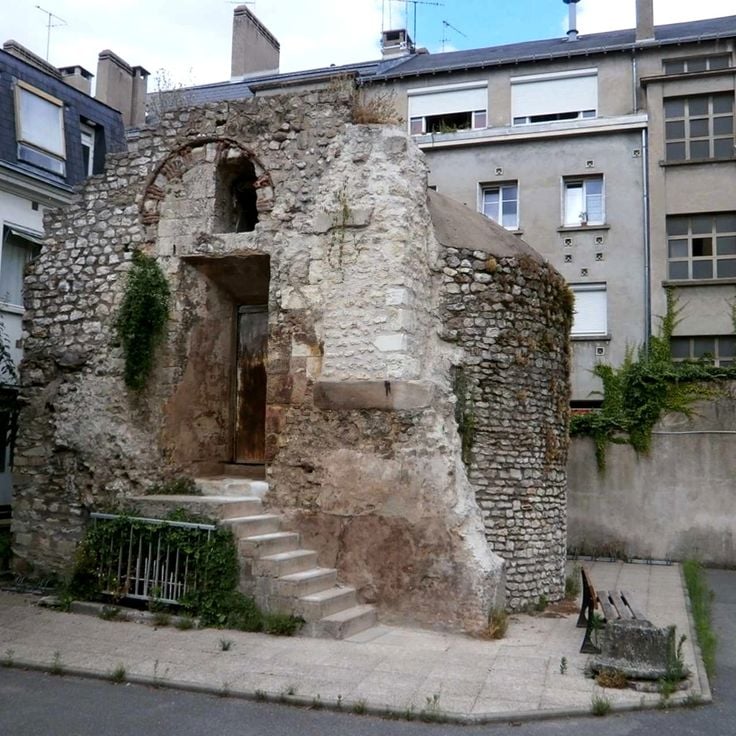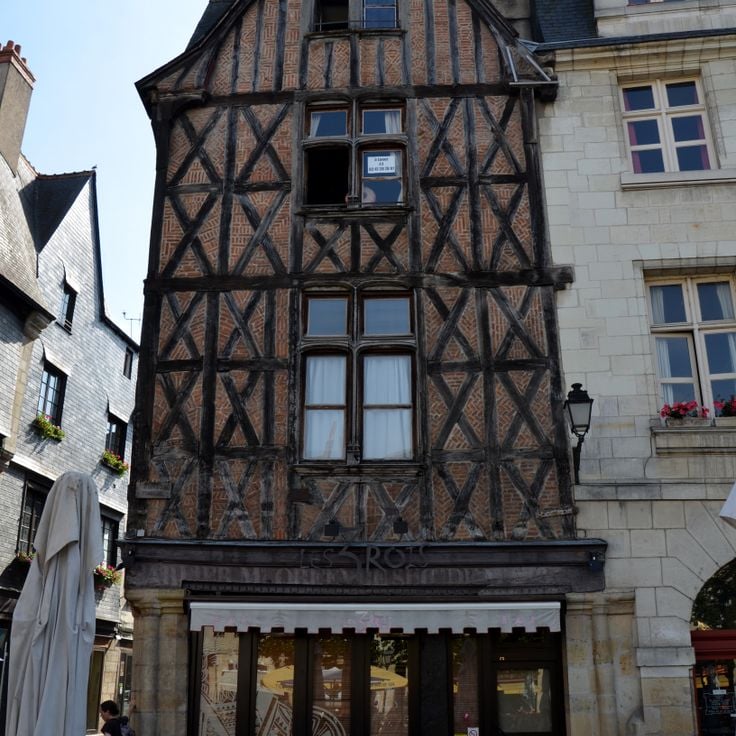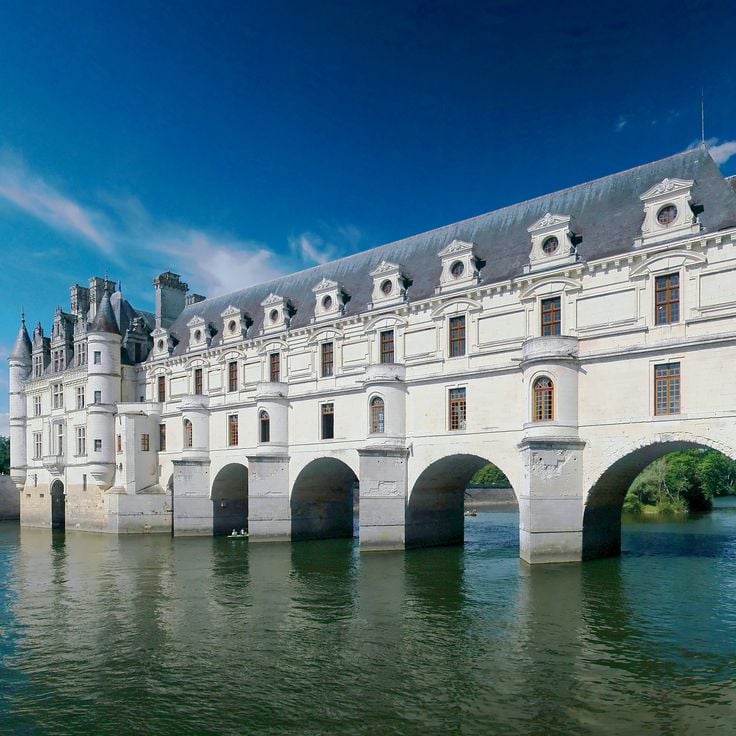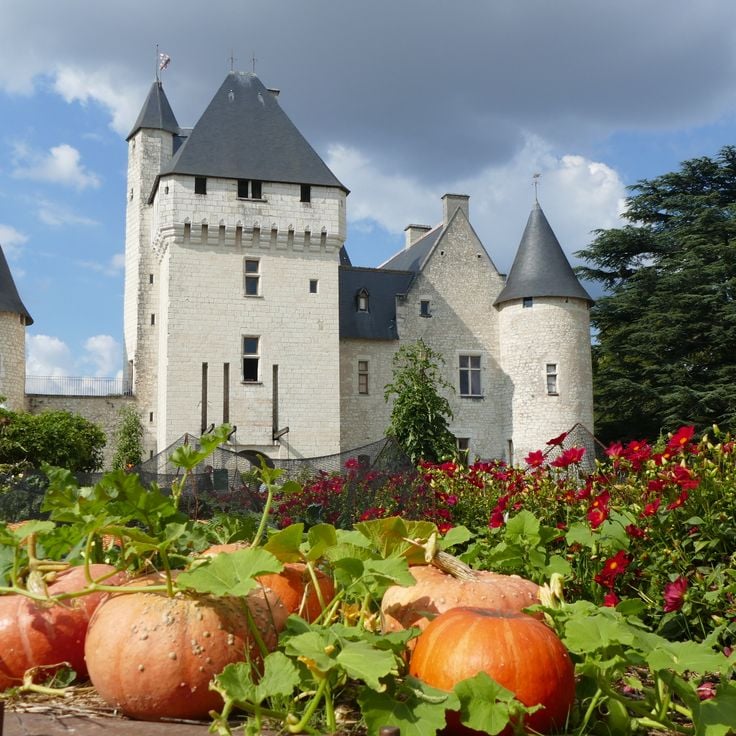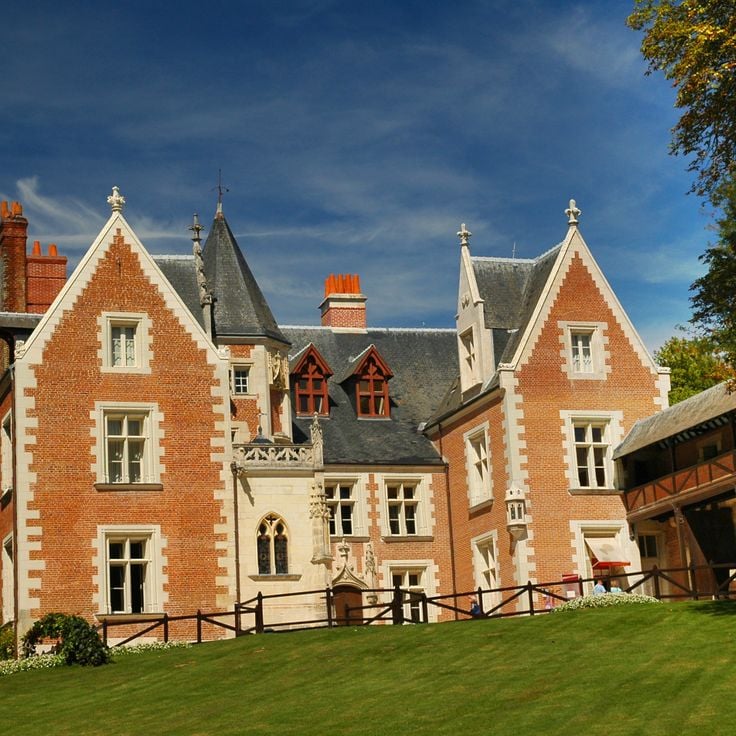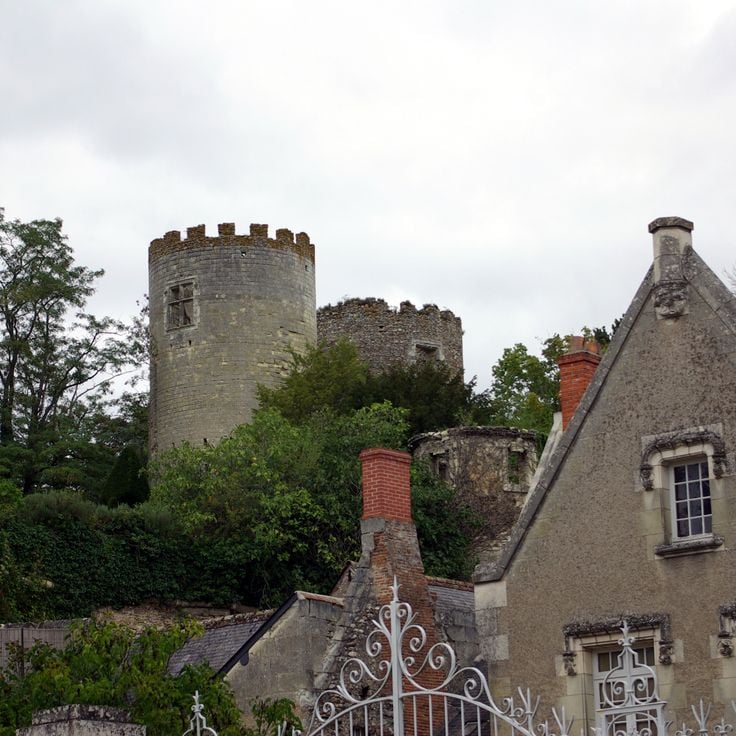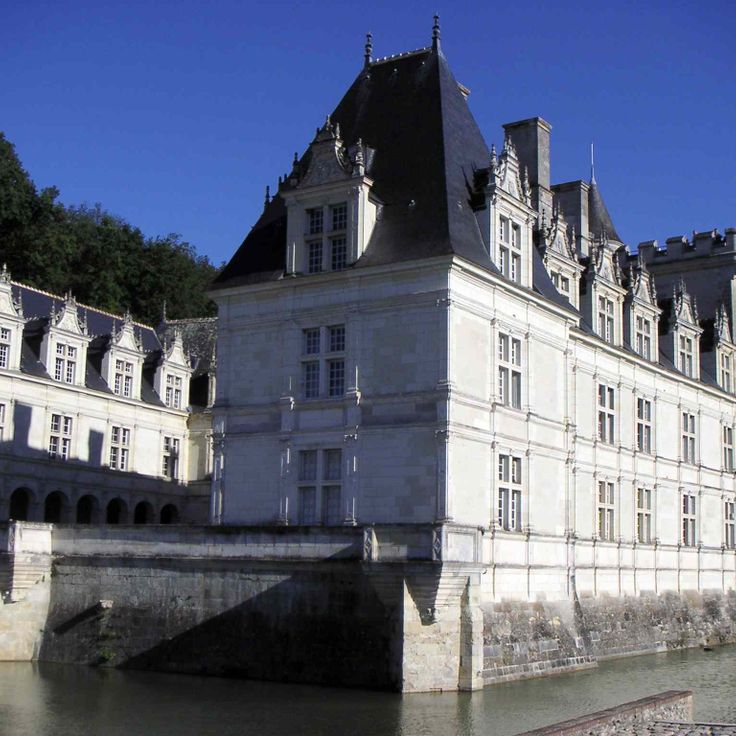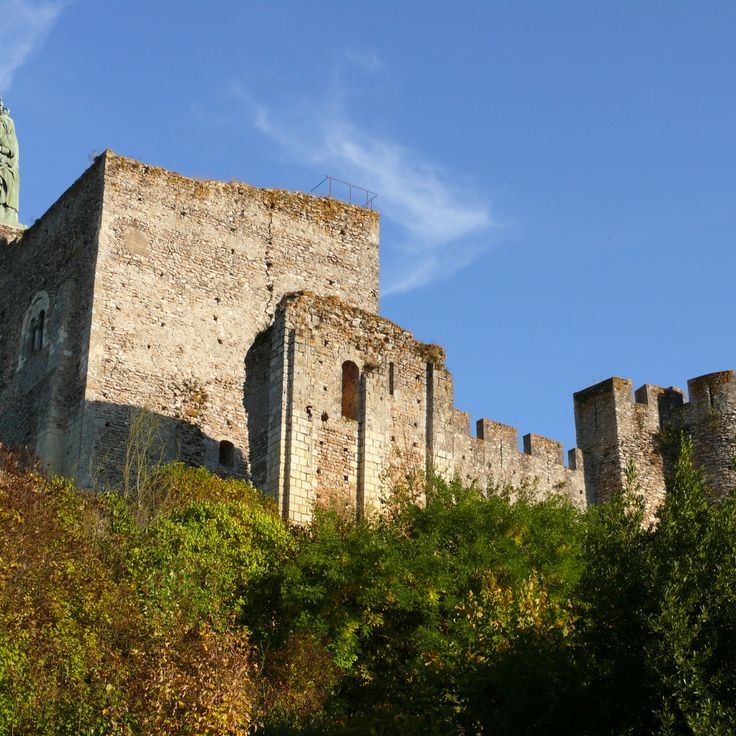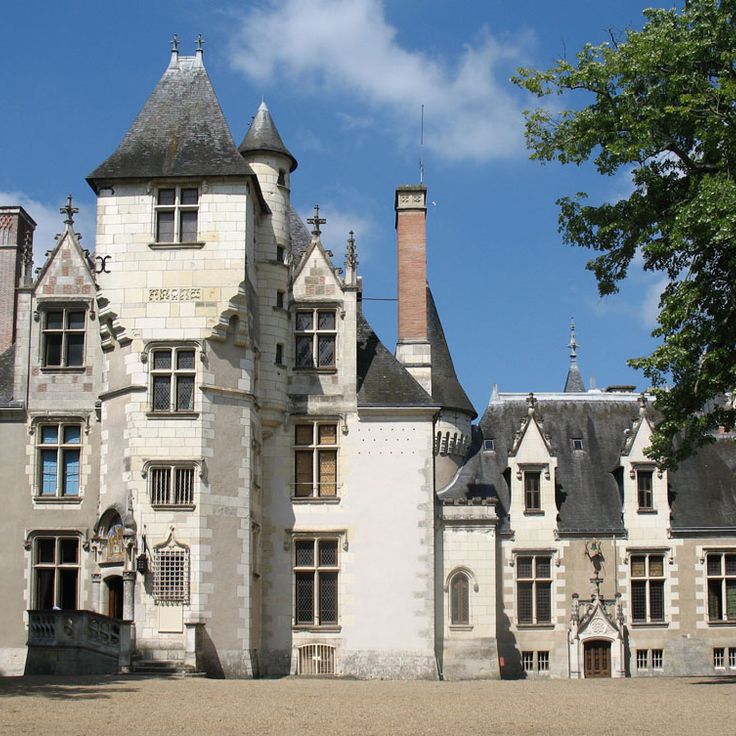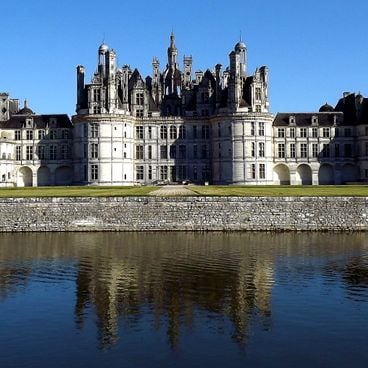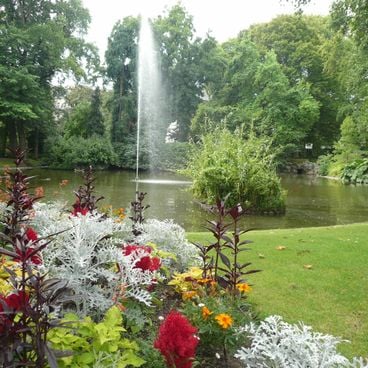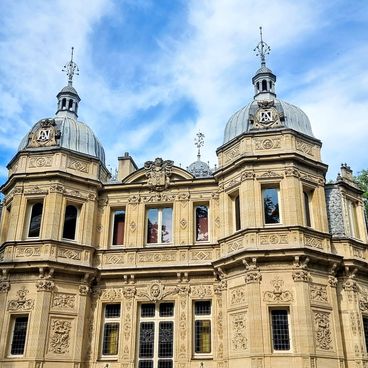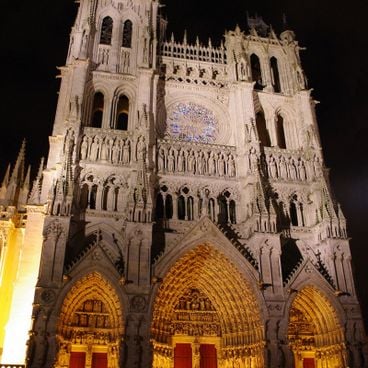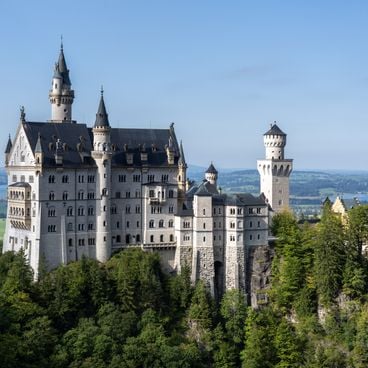The Loire Valley features Gothic cathedrals, Renaissance châteaux and medieval squares. From Saint-Gatien Cathedral to Château de Chenonceau, each location displays architectural details: towers, stone walls, decorated facades and geometric gardens. The city of Tours combines half-timbered houses, bridges over the Loire, religious buildings and public squares with century-old trees. Saint-Gatien Cathedral rises with its two towers and stained glass windows from the 13th century in the heart of Tours. Château de Chenonceau spans the Cher River with its galleries and French gardens. Place Plumereau in the historic center is surrounded by medieval houses with wooden beams. The Loire châteaux such as Amboise, Villandry and Azay-le-Rideau offer photographs of white stone facades, towers and terraced gardens. The banks of the Loire reveal sandy beaches, old stone bridges and vineyards stretching along the river.
The Langeais suspension bridge was built in the 19th century and crosses the Loire River with a span of 160 meters. The construction consists of metal cables stretched between two solid stone pillars. This bridge connects both banks of the river and provides a link between several communes in the region. The stone pillars rise directly from the riverbed and support the entire structure.
Place Plumereau forms the historic center of Tours and displays medieval architecture from the 15th century. This square brings together several timber-framed houses with exposed wooden beams and plastered panels. The ground consists of traditional stone paving. Numerous restaurants have set up their tables on the terrace, giving the place a social function. The buildings present various architectural styles from the late Gothic and Renaissance periods.
Saint-Gatien Cathedral was built between 1170 and 1547, spanning different periods of Gothic architecture. The building displays elaborate stonework on its portals and facades. The stained glass windows date from the 13th to 16th centuries and depict biblical scenes in vivid colors. The two towers rise over 70 meters high. The nave extends across several bays with pointed arch vaulting. The western facade combines Gothic and Renaissance elements. The choir features a ring of chapels with refined architectural details.
This public garden was created in 1872 following the English landscape style and spans several hectares in the heart of Tours. The grounds feature shaded paths beneath mature trees, including plane trees, lindens, and cedars. Several fountains and water basins enhance the walking routes, while maintained flowerbeds and expansive lawns provide areas for rest. The Jardin des Prébendes d'Oé combines historical garden design with botanical diversity and serves residents as a recreational space.
The Pont Wilson spans the Loire River over 434 meters with 15 stone arches. This bridge was built in 1778 and connects the center of Tours to the southern neighborhoods. The structure, made from local stone, serves as a major crossing for pedestrians and vehicles. From the bridge, views extend across the river and its banks.
The Tours City Hall was built in 1786 and displays Renaissance architectural style. The central tower features four clocks and a bell that mark the city's time. The facade showcases classical columns and several statues that add to the building's formal character. Located in the historic center of Tours, it serves as the municipal administration headquarters.
The Musée des Beaux-Arts in Tours occupies the former archiepiscopal palace dating from the 17th and 18th centuries, located next to the Saint-Gatien Cathedral. The museum displays extensive collections of European paintings from the 14th to the 20th century, including works by Italian primitives, Flemish and Dutch masters, and French artists such as Mantegna, Rubens, Rembrandt, Boucher, and Delacroix. The sculpture collection features pieces by important French sculptors, while the rooms also present period furniture and decorative objects.
The Château de Tours is an 11th-century fortress located in the heart of Tours. The remaining towers and walls demonstrate medieval defensive architecture. Today, this château serves as an exhibition space dedicated to contemporary photography and modern art. The venue hosts rotating exhibitions featuring regional and international artists. The historic stone walls provide a setting for the displayed works.
The Basilica of Saint Martin was built in the 19th century in Neo-Byzantine style over the tomb of Saint Martin. The bell tower rises 40 meters above the city center of Tours. The church replaces an earlier Romanesque basilica destroyed during the French Revolution. The interior houses the crypt containing the tomb of Saint Martin, Bishop of Tours in the 4th century.
Place Anatole France is a public square in Tours located near the Loire River. This square connects the historic city center with the riverbank and the Wilson Bridge. Several plane trees provide shade over the benches that invite visitors to rest. The surrounding streets lead to shops, cafés and restaurants of the Touraine region. The square serves as a passage for pedestrians and cyclists traveling between different neighborhoods of the city.
The Cloître de la Psalette is a 15th-century Gothic cloister adjacent to the Cathedral of Saint-Gatien. This cloister features stone vaulted ceilings with decorated ribs, numerous gargoyles, and ornate galleries that demonstrate medieval craftsmanship. The columns and arches form a rectangular courtyard that once served as a passage and meditation space for the cathedral canons. The complex also includes a library room and a scriptorium, accessible via a spiral staircase.
Place Jean Jaurès serves as the main public square in Tours, surrounded by stone buildings from the 19th century. Trees line the square, providing shade over public benches. The ground floors of the buildings house numerous restaurants and cafés with outdoor terraces. A fountain stands at the center of the square. This location functions as a meeting point for residents and visitors to the city.
The Tour Charlemagne is a stone tower from the 12th century that rises 48 meters high. This tower marks the former position of the bell tower of the Saint-Martin Basilica, which was once among the most important pilgrimage sites in Europe. After the destruction of the basilica during the French Revolution, the Tour Charlemagne remained as one of the few visible remnants of this religious complex and stands today in the center of Tours.
The Prieuré Saint-Cosme was founded in the 11th century and served for centuries as a priory of the Abbey of Saint-Julien de Tours. This religious complex preserves several Romanesque and Gothic stone buildings, including the remains of the priory church and the refectory spaces. The poet Pierre de Ronsard spent the final years of his life here as commendatory abbot and was buried in the church in 1585. The grounds also include French-style gardens laid out according to historical plans, showcasing various plant species cultivated during the Renaissance period.
Hôtel Goüin is a 15th-century townhouse located in central Tours. The facade displays elaborate stone carvings in Renaissance style, featuring floral motifs and geometric patterns. The building survived World War II largely intact while much of the old town was destroyed. Today, this historic structure serves as an exhibition space for art collections and temporary displays. The architecture combines Gothic elements with early Renaissance features.
Avenue La Tranchée connects the northern and southern parts of Tours since the 19th century. This major thoroughfare offers direct views of the two Gothic spires of Saint-Gatien Cathedral rising above the city rooftops. The wide street crosses through different neighborhoods and allows photographers to capture the historic cathedral architecture from an unusual perspective.
The Centre de Création Contemporaine Olivier Debré is a contemporary art museum housed in a transparent concrete and glass building opened in 2016. The exhibition spaces showcase works by modern artists, large-scale paintings and multimedia installations. The center bears the name of French painter Olivier Debré and is dedicated to promoting current artistic expressions through rotating exhibitions and cultural events.
The Château de Plessis-lès-Tours served as a royal residence during the 15th century and stands on the banks of the Loire River. King Louis XI chose this location as his preferred dwelling and died here in 1483. The complex preserves portions of the original fortifications and foundations from its construction period. The remaining brick structure displays the characteristic architecture of royal residences from this era. The grounds combine historical building elements with later modifications and document several centuries of French history.
The Church of Saint-Julien was built in the 13th century following Romanesque architectural principles and features large rose windows. This religious edifice displays stone sculptures throughout its central nave and side aisles. The structure combines religious function with Romanesque construction techniques and provides visitors with an example of medieval sacred architecture in the Tours region.
The Pont de Fil is a traffic bridge over the Loire River inaugurated in 2013 in Tours. This modern structure connects both riverbanks and is dedicated exclusively to buses and pedestrians. The bridge provides a direct crossing of the river and contributes to improving urban mobility in the city.
This garden clock on Boulevard Heurteloup displays functional timekeeping through mechanical hands that move above a circular bed of seasonal plants and ornamental flowers. The installation combines horticultural design with practical timekeeping in Tours' public space.
The Moulin Bleu was built in the 19th century and features four rotating blue sails mounted on a white stone tower. This working windmill stands on a small hill and dominates the landscape of Bourgueil. The characteristic blue color of the sails contrasts distinctly with the light stone construction. The location offers wide views over the vineyards of the region.
The Fortifications of Châteauneuf consist of 13th-century stone defensive walls that surround the old town of Tours. This medieval defence system includes several defensive towers and protected the historic merchant quarter of the city. The walls bear witness to the strategic importance of Tours during the Middle Ages and today form a circuit through the historic urban architecture.
Rue du Grand Marché runs through the historic center of Tours, connecting Place Plumereau to the Basilica of Saint-Martin. This medieval commercial street features half-timbered houses from the 15th century with exposed wooden beams and plastered facades. The cobblestone lane hosts local shops, cafés, and restaurants in the ground floors of the old buildings. The street documents late Gothic urban architecture in the Centre-Val de Loire region.
The Château de Chenonceau was built in the 16th century spanning the River Cher, using the foundations of an old mill as its bridge base. This former royal residence displays richly furnished halls with Renaissance furniture, tapestries and painting collections. The architecture combines French construction techniques with Italian influences. Two formal gardens frame the building, while the gallery bridge extends over the water, giving the château its distinctive silhouette.
The Château du Rivau is a 13th-century medieval fortress expanded in the 15th century. The structure combines defensive features with Renaissance elements including sculpted chimneys and decorated facades. Fourteen themed gardens spread across twelve hectares showcase historical plant varieties and contemporary landscape design. The castle hosts rotating exhibitions of modern art within its historical chambers. The 15th-century stables remain intact and demonstrate the architectural quality of the outbuildings.
The Clos Lucé is a Renaissance manor house where Leonardo da Vinci spent the final three years of his life. The Italian master worked here under the patronage of King Francis I, developing his projects and inventions. The rooms display period furniture from the 16th century and reproductions of his paintings. Throughout the estate, forty working models of his mechanical inventions are exhibited, including flying machines, military devices, and hydraulic systems. The gardens feature monumental versions of his technical designs set within the natural landscape.
The Château de Cinq-Mars-la-Pile is a medieval fortress from the 12th century built on a rocky spur overlooking the Loire plain. The site consists of the ruins of several towers and walls that demonstrate military architecture from the Middle Ages. The main tower reaches a height of over 30 meters. The fortress was owned by influential French noble families and played a strategic role during the Wars of Religion. The grounds offer views over the Loire Valley and surrounding vineyards.
The Château de Villandry ranks among the last great Renaissance castles built in the Loire Valley. The estate is particularly known for its six distinct garden sections spread across multiple terraced levels. The ornamental garden features carefully trimmed boxwood hedges arranged in geometric patterns, while the vegetable garden follows historical designs from the 16th century. Water basins, fountains, and channels flow through the grounds, forming a coherent design alongside flower beds. The gardens are replanted twice annually, displaying different color compositions depending on the season.
The Forteresse de Montbazon was built in the 11th century and stands as one of the oldest surviving stone keeps in France. The rectangular tower rises from a rocky promontory overlooking the Indre Valley. The fortress complex includes stone walls, defensive towers, and remnants of medieval fortifications. The site organizes historical demonstrations with costumed interpreters who recreate medieval life. Guided tours explain the military architecture and the strategic importance of the fortress in the Touraine region. From the ramparts, visitors can view the surrounding landscape and the town of Montbazon below.
The Domaine de Candé is a historic estate that combines a Renaissance château with elements of medieval and modern architecture. The property spans 250 hectares of forest and gardens, featuring a golf course and several historic rooms known for their refined design. The château served as the venue for the 1937 wedding of Edward VIII and Wallis Simpson.
The Château d'Azay-le-Rideau rises from an island in the Indre River and represents French Renaissance architecture from the early 16th century. White tufa stone walls contrast with dark slate roofs and reflect in the surrounding water. The facades display Italian influences with regular rows of windows and decorative pilasters. The interior contains original wooden staircases and period tapestries. English-style gardens surround the building and provide different perspectives on the architecture.
